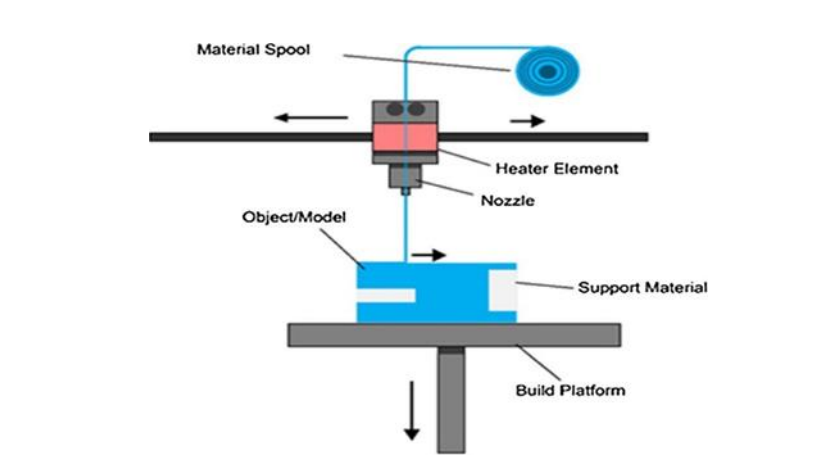FDM 3D Printing: Detail Explanation
The FDM or Fused Deposition Modelling is also known as Fused Filament Fabrication (FFF) is a 3D printing process which uses thermoplastic filament materials in continuous form. The thermoplastic filament coil is passed through an extruder which contains a heating coil. The extruder heats the filament just past its glass transition temperature, after which this molten filament is extruded on the print bed of the 3D printer. This “Material
Extrusion” method is widely used in different industries.
S. Scott Crump the founder of Stratasys Ltd. was the first person who developed FDM technology and commercialized the first FDM 3D printer in 1988. Stratasys also trademarked the term “Fused Deposition Modelling” in the year 1991.
These FDM 3D printers were expensive when it was first commercialized but after the
expiration of the patent in 2009 many different companies entered the market
offering cheap, DIY FDM 3D Printers like the Ultimaker, Prusa, and many others.
FDM Fabrication Process:
Every 3D Printing process
starts by developing a CAD (Computer Aided Design) file in a 3D software. This 3D file is converted into
STL (Stereolithography) file.
This file is then transferred
to a repairing software where this 3D .stl files get some correction in
triangle counts, surface smoothing, shell repair, etc.
After repairing the
operator of the 3D Printer needs to put some support to this file which helps
the file to print on the machine print bed. These supports are put manually or
by using auto generating support given in almost all 3D Machine software. AutodeskNetfabb, Materialise Magics, these two software are used by almost every 3D
modeling software users for repairing and support generation.
 |
| Autodesk Netfabb Software |
Once the support structure is
done the .stl file is now ready to print. The file is now processed into the
machine software where it is cut horizontally into thin slices. The thickness
of the slice depends on the microns you set in the instruction column. Normally
the FDM printer micron range from 50 Micron to 400 Micron.
The whole 3D file is now
converted into a set to program or machine language called the G-codes by which
the 3D printer works.
The FDM 3D Printer consists of
the print bend which has up and down movement guided by a stepper motor. An
extruder containing heating coils which melts the thermoplastic filaments and
drops the heated material on the print bed through a nozzle.
The extruder is mounted on a moving platform which moves in XY direction guided by the stepper motor as
there should be precise movement of the extruder.
 |
| Stepper Motor attached to Extruder Platform |
The melted filament is
extruded in thin strands on the print bed layer by layer on the predetermined
location as per the codes given by the 3D printer software. This melted
filament solidifies as it touches the print bed or the layer printed before.
Sometimes the product is made
hollow to reduce the weight and matrix or web type structure is made inside the
product to give strength to the product. For this type of structure, the
extruder needs to make multiple passes like the one when we fill colors with
crayons which need an increase in filament cooling. A set of cooling fans is
attached to the extruder which accelerates the filament cooling.
FDM Materials:
The reason that FDM
3D printers are one of the successful and widely used technology is because of
its variety of materials in production materials. These materials are regular
thermoplastics, engineering materials, and high-performance thermoplastics
materials. The use of these materials varies based on its mechanical properties,
accuracy, and material price.
FDM Post Process:
Once the product is printed it undergoes support removal and post-processing. The supports given to the part are removed with the cutter or by hand
as they are easy to remove.
After the supports are removed the product needs some
cleaning and smoothing as they show some visible lines on the object. Hand
sanding and filing is done on most parts and some parts also need polishing to
get a shining surface. Painting can be done on the 3D printed parts to make it
look more attractive.
Facts about FDM 3D Printer:
FDM 3D Printers are very
cost-effective in terms of machine procurement and even in outsourcing product
manufacturing. It also takes very less time to finish the job which means we
can get the work completed within 24 hours.
FDM printer can also print end-user engineering products. Materials like Nylon (PA), PTEG, TPU can be used to
make industrial-grade parts with good mechanical, thermal, and chemical properties.
Engineers in the industries get a huge benefit from FDM printing as they don’t have
to wait for the broken part of the machine to be replaced, they can 3D print it
and use it on their own.
FDM 3D Printer has made their
position in many top industries like automobile companies like the Hyundai and BMW, food companies like Nestle, and many other giant manufacturing
companies. It is used for product development, prototyping, and model concept as
this technology is simple and cost-effective plus it does not damage the environment.
The medical and health care industry has started using 3D printer in
their process. The FDM printer is used in the drug packaging sector which makes it
popular in the medical sector as well.
Limitation FDM 3D Printer:
Despite all the advantages
that FDM 3D printer has there are also some limitations which need to be
consider before choosing FDM printer for your manufacturing setup:
- Unlike other 3D Printing technologies, FDM has the lowest dimensional accuracy and surface finish, so it is preferable to not use this technology for product which need detailed accuracy.
- Every FDM printed parts will have to undergo the post process of smoothing and polishing as the surface achieved is very rough and has visible lines.





Comments
Post a Comment